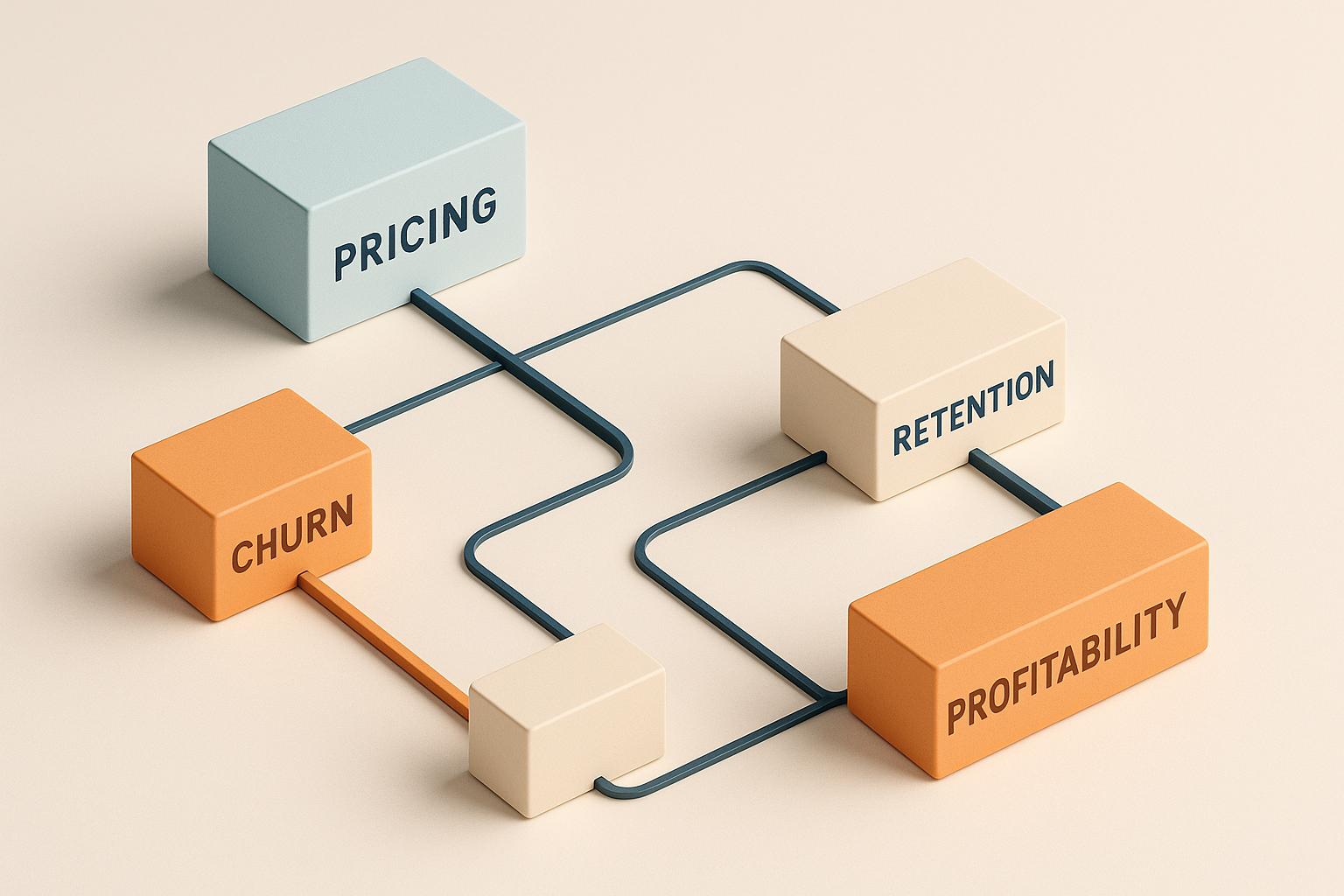Tax Shield Impact on WACC Explained

Tax shields lower a company's Weighted Average Cost of Capital (WACC) by reducing taxable income through interest deductions on debt. This makes debt financing cheaper than equity, as interest is tax-deductible while dividends are not. Here's how it works:
-
Tax Shield Formula:
Tax Shield = Interest Expense × Tax Rate.
Example: With $1,000,000 in interest and a 21% tax rate, the tax shield is $210,000. -
WACC Formula:
WACC = (E/V × Re) + (D/V × Rd × (1 - Tc)).
The term (1 - Tc) reflects the tax savings from debt, lowering the after-tax cost of borrowing. - Key Impact: A lower WACC reduces the required returns for projects, boosting enterprise value. For example, a company with a 10% cost of debt and a 25% tax rate sees its after-tax cost drop to 7.5%.
Balancing debt and equity is crucial for maximizing tax benefits while managing financial risks. Companies with steady cash flows often benefit more from leveraging tax shields, especially in high-tax jurisdictions. Ignoring this can lead to undervaluing your business and poor financial decisions.
How Tax Shields Work
Tax shields reduce taxable income by allowing companies to deduct interest expenses. When a business pays interest on borrowed funds, that expense is subtracted from its earnings before taxes are calculated. This lowers the company's tax liability, resulting in immediate savings that enhance cash flow.
By reducing taxable income through interest deductions, tax payments decrease right away. This process, captured in a straightforward formula, highlights the practical value of tax shields.
Tax Shield Calculation Formula
The tax shield is calculated using the formula:
Tax Shield = Interest Expense × Corporate Tax Rate
This formula applies only to profitable companies, as a business must have taxable income to benefit from the deduction. If a company operates at a loss, the calculation becomes irrelevant since there’s no tax liability to offset.
For example, with an interest expense of $1,000,000 and a 21% tax rate, the annual tax shield amounts to $210,000.
| Scenario | Interest Expense | Tax Rate | Tax Shield Savings |
|---|---|---|---|
| Small Business | $15,000 | 20% | $3,000 |
| Mid-Size Company | $1,000,000 | 21% | $210,000 |
| Large Corporation | $800,000 | 35% | $280,000 |
Financial Impact of Tax Shields
The savings from tax shields go beyond reducing tax payments - they also lower the effective cost of financing. By easing the burden of interest expenses, tax shields improve liquidity, allowing businesses to reinvest in growth, pay down debt, or build financial reserves for future needs.
This mechanism makes debt financing more attractive than equity financing. Unlike interest payments, dividends paid to shareholders do not qualify for tax deductions, giving debt a clear advantage in terms of tax benefits. As a result, many companies strategically incorporate debt into their capital structure to take advantage of these savings.
Tax shields provide predictable, immediate benefits that simplify budgeting and financial planning. Companies in high-tax jurisdictions, in particular, gain even more from tax shields. For example, a business subject to a 35% tax rate saves significantly more per dollar of interest expense compared to one operating under a 21% rate. This makes debt financing especially appealing in areas with higher tax rates.
WACC Formula and Tax Shield Integration
The Weighted Average Cost of Capital (WACC) formula incorporates the tax benefits of debt through its debt component, effectively capturing how borrowing can reduce overall financing costs. Let’s break down the formula to see how these tax benefits are factored into the calculation.
WACC Formula Components
The WACC formula is expressed as: WACC = (E/V × Re) + (D/V × Rd × (1 - Tc))
Here’s what each term represents:
- E: Market value of equity
- V: Total market value of financing (equity + debt)
- Re: Cost of equity capital
- D: Market value of debt
- Rd: Pre-tax cost of debt
- Tc: Corporate tax rate
The formula assigns weights to each financing source based on its share of the total capital. The equity component (E/V × Re) reflects the cost of raising funds through equity, while the debt component (D/V × Rd × (1 - Tc)) accounts for the after-tax cost of borrowing.
For instance, if a company has $3 million in equity and $2 million in debt, equity makes up 60% of the total capital, while debt accounts for 40%.
After-Tax Cost of Debt Calculation
The term (1 - Tc) in the formula adjusts for the tax shield, which lowers the effective cost of debt. This adjustment reflects the actual borrowing cost after factoring in the tax benefits from interest deductions.
The after-tax cost of debt is calculated as:
After-tax cost of debt = Pre-tax cost of debt × (1 - Tax rate)
For example, if a company pays 8% interest on its debt and has a corporate tax rate of 21%, the after-tax cost of debt drops to 6.32%:
8% × (1 - 0.21) = 6.32%
This calculation highlights how tax shields can significantly reduce borrowing costs. It’s important to use the company’s expected future tax rate for accuracy, as changes in tax rates affect borrowing costs over time.
Practical Example of Tax Shield Impact
Consider a manufacturing company with a total capital structure of $10 million, consisting of $6 million in equity and $4 million in debt. Assume the cost of equity is 12%, the pre-tax cost of debt is 7%, and the corporate tax rate is 25%. The WACC calculation would look like this:
WACC = (0.6 × 12%) + (0.4 × 7% × (1 - 0.25)) = 7.2% + 2.1% = 9.3%
Without accounting for the tax shield, the debt’s contribution would increase to 2.8%, raising the WACC to 10.0%. This means the tax shield reduces the WACC by 0.7 percentage points, showing how tax advantages can make a meaningful difference in a company’s financing decisions.
sbb-itb-e766981
Using Tax Shields to Optimize Capital Structure
Fine-tuning your debt-to-equity ratio can help you take full advantage of tax shields while reducing your Weighted Average Cost of Capital (WACC). The goal is to strike a balance where the tax benefits from debt financing outweigh the risks and costs associated with higher leverage. This balance depends on factors like your company’s cash flow consistency, industry norms, and overall financial health. These considerations naturally lead into weighing the pros and cons of debt versus equity financing.
Debt vs. Equity Financing Trade-offs
Debt financing offers a clear perk: interest payments are tax-deductible, which lowers borrowing costs. On the other hand, equity financing doesn’t provide such deductions, making debt financing more attractive from a tax perspective. However, relying too heavily on debt can increase financial risk, especially if your company struggles to meet payment obligations.
Companies with steady, predictable cash flows are better equipped to handle higher debt levels since they can service debt payments even during tough times. In contrast, businesses with more unpredictable or volatile cash flows should lean on equity financing and keep debt levels lower. Industry norms also play a role - capital-intensive sectors like manufacturing and finance often carry higher debt ratios, sometimes exceeding 2.0. For most businesses, though, a healthy debt ratio typically falls between 1.0 and 1.5.
Steps to Lower Your WACC
To optimize your capital structure and lower your WACC, follow these steps:
-
Analyze Your Current Structure
Start by examining how your existing mix of debt and equity contributes to your overall financing costs. Use market values for both debt and equity to determine their respective percentages:- Debt % = Debt ÷ (Debt + Equity)
- Equity % = Equity ÷ (Debt + Equity)
-
Calculate Your Cost of Debt
If your company has publicly traded bonds, use the yield to maturity of your long-term debt. For companies with a credit rating but no public debt, add the default spread for your rating to the risk-free rate. If you lack a formal credit rating, use the interest rate on your most recent long-term debt or estimate the default spread based on your interest coverage ratio (EBIT ÷ interest). -
Factor in Tax Shields
Consider your future tax rate when calculating the benefits of tax shields. If your current effective tax rate is lower than the statutory rate but expected to rise, account for this change in your projections. Use the future tax rate for WACC calculations, as it reflects the rate your company is likely to face moving forward. -
Benchmark Against Peers
Compare your leverage to industry competitors and evaluate what level of debt lenders might find acceptable, considering your business risks and the capital structures of similar companies. Keep in mind that debt tax shields can contribute up to 10% of a firm’s value, making this analysis highly impactful.
Instead of aiming for a single "perfect" debt-to-equity ratio, consider operating within a range of leverage levels. This approach allows you to reap meaningful tax benefits while staying aligned with your company’s strategic goals and growth plans.
If you’re navigating these decisions and need expert advice, Phoenix Strategy Group offers fractional CFO services and financial advisory support. They specialize in helping growth-stage companies refine their capital structures and prepare for future funding rounds or exits.
Tax Shields and WACC: Key Points
Tax shields play a crucial role in lowering your company's cost of capital by making debt financing more affordable. Here's how it works: interest on debt is tax-deductible, which reduces your tax burden and, in turn, cuts down borrowing costs.
For instance, a company with a 10% cost of debt and a 25% tax rate ends up with an after-tax cost of debt of just 7.5%. This savings directly factors into your Weighted Average Cost of Capital (WACC), bringing down your overall financing expenses.
Overlooking tax shields can lead to undervaluing your business. Studies indicate that tax shields contribute roughly 10% to corporate valuations. This makes them a critical consideration in financial planning, especially for growth-stage companies. For these businesses, decisions about capital structure can significantly influence future funding rounds and exit valuations.
Interestingly, only 31% of public companies generate returns exceeding their WACC. This highlights the difficulty of navigating tax regulations while maintaining financial health. For growth-stage businesses, this challenge can be even more pronounced, making expert financial modeling and strategic advice essential to optimize tax benefits without overextending on debt.
Achieving the right balance between leveraging tax shields and managing financial risk demands a solid grasp of industry trends, cash flow dynamics, and long-term strategic objectives.
FAQs
How do tax shields influence a company's choice between debt and equity financing?
Tax shields are an important factor when companies decide between debt financing and equity. Why? Because the interest paid on debt is tax-deductible, which lowers taxable income and, in turn, reduces the overall cost of borrowing. This tax benefit makes debt a more affordable choice compared to equity, which doesn’t provide the same tax perks.
By utilizing tax shields, businesses can boost their value through the savings on taxes. That said, while debt may seem appealing, companies need to carefully consider the financial risks that come with higher leverage - like cash flow challenges or increased financial vulnerability. Balancing these factors is key to making the right financing decisions.
What should companies consider when balancing debt and equity to maximize tax shield benefits?
When determining the right balance between debt and equity to maximize tax shield benefits, companies need to carefully weigh a few critical factors:
- Business risk: If a company operates in a high-risk environment, borrowing costs tend to rise, and the chance of default increases. These factors could cancel out the tax perks associated with taking on debt.
- Financial health: A company’s ability to repay debt is essential. Overextending with loans can lead to financial troubles or even bankruptcy, which would overshadow any tax savings.
- Industry norms and market conditions: It’s wise to assess what’s common in your industry and how prevailing interest rates might influence the cost of borrowing.
The key is finding a middle ground where the tax benefits of debt outweigh the risks of financial strain, all while keeping the company nimble enough to seize future growth and investment opportunities.
How do changes in corporate tax rates affect tax shields and WACC?
Corporate tax rates significantly impact the Weighted Average Cost of Capital (WACC) by influencing the value of tax shields. When tax rates are reduced, the value of the interest tax shield diminishes. This leads to a higher after-tax cost of debt, which can cause WACC to rise. Conversely, higher tax rates increase the value of the tax shield, lowering the after-tax cost of debt and, in turn, reducing WACC. This makes debt financing a more attractive option under higher tax conditions.
These changes in WACC have a direct effect on a company's valuation and its investment decisions. As a result, incorporating accurate tax rate assumptions into financial models is crucial for businesses striving to optimize their capital structure and align with their long-term goals.




